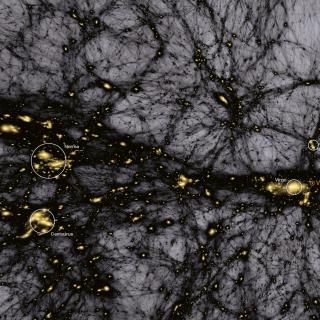Bibcode
Coloma-Nadal, J. M.; Kitaura, F. -S.; García-Farieta, J. E.; Sinigaglia, F.; Favole, G.; Forero Sánchez, D.
Referencia bibliográfica
Journal of Cosmology and Astroparticle Physics
Fecha de publicación:
7
2024
Número de citas
3
Número de citas referidas
2
Descripción
Accurate modeling of galaxy distributions is paramount for cosmological analysis using galaxy redshift surveys. However, this endeavor is often hindered by the computational complexity of resolving the dark matter halos that host these galaxies. To address this challenge, we propose the development of effective assembly bias models down to small scales, i.e., going beyond the local density dependence capturing non-local cosmic evolution. We introduce a hierarchical cosmic web classification that indirectly captures up to third-order long- and short-range non-local bias terms. This classification system also enables us to maintain positive definite parametric bias expansions. Specifically, we subdivide the traditional cosmic web classification, which is based on the eigenvalues of the tidal field tensor, with an additional classification based on the Hessian matrix of the negative density contrast. We obtain the large-scale dark matter field on a mesh with ~3.9 h -1 Mpc cell side resolution through Augmented Lagrangian Perturbation Theory. To assess the effectiveness of our model, we conduct tests using a reference halo catalogue extracted from the UNIT project simulation, which was run within a cubical volume of 1 h -1 Gpc side. The resulting mock halo catalogs, generated through our approach, exhibit a high level of accuracy in terms of the one-, two- and three-point statistics. They reproduce the reference power-spectrum within better than 2 percent accuracy up to wavenumbers k ~ 0.8 h Mpc-1 and provide accurate bispectra within the scales that are crucial for cosmological analysis. This effective bias approach provides a forward model appropriate for field-level cosmological inference and holds significant potential for facilitating cosmological analysis of galaxy redshift surveys, particularly in the context of projects such as DESI, EUCLID, and LSST.
Proyectos relacionados

Cosmología con Trazadores de la Estructura a Gran Escala del Universo
El Fondo Cósmico de Microondas (FCM) contiene la información estadística de las semillas primigenias que han dado lugar a la formación de todas las estructuras en el Universo. Su contrapartida natural en el Universo local es la distribución de las galaxias que surgen como resultado del crecimiento gravitatorio de aquellas fluctuaciones de densidad
FRANCISCO SHU
KITAURA JOYANES